Want an effective way to promote limited-time offers or events? Have you considered a temporary Facebook group?
In this article, you'll discover how to run a pop-up Facebook group for business.
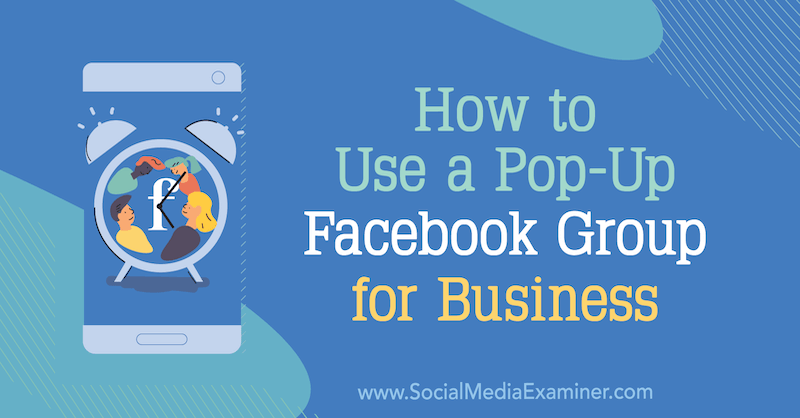
When to Use a Pop-Up Facebook Group
Unlike regular groups, a pop-up Facebook group is a limited-time experience. Members have the opportunity to learn more about you, your company, and the problems you're trying to solve, with the intention of generating sales for a service or offering. Think of it as a pre-launch event.
Even more powerful, you can use your pop-up group as a pre-launch tool and then pitch your sales process, which is also front-ended with something free like a webinar or video series.
Keep in mind that the group's purpose is to focus on the “what” and the “why.” The mistake some marketers make is focusing too much on the “how” in the pop-up phase, which can turn people off. If your pop-up group is heavy on to-do's and fills people's feeds with lessons and actions for 4 weeks before even getting to a pitch, you may lose them.
Your paid offer at the end focuses on the how—the actionable strategies for people to achieve their goal. The pop-up group's purpose is to identify ways people can get ready and feel empowered to take the next step in the process. Think of your group as a means to quickly grow a community of engaged people who are excited about a topic (the group's focus), help them look past any apprehensions they may have, and prime them for a sale.
You can't just launch a pop-up Facebook group without putting some careful thought into it, however. You need a plan to attract members to join your group, a compelling agenda, and strategies in place for closing a sale.
This article assumes you know how to properly set up a Facebook group. You can watch this playlist to learn more about setting up a Facebook group for business:
#1: Choose the Time Frame for Your Pop-Up Facebook Group
The time frame for a pop-up Facebook group is different for everyone. Some marketers have found the most success with pop-ups shorter than 14 days. With that relatively short duration, people are more likely to stay engaged and the excitement and momentum can remain strong. Plus, it doesn't feel like too much of a commitment. (Remember, people are busy and social media can be distracting.)
Other marketers have found success with 30- or even 60-day pop-up Facebook groups. It just depends on the audience, agenda, and topic you're discussing.
To find the right timetable for your group, you need to experiment, get feedback, and make changes if needed. Your goal is not only to give people a quick win but also to overcome their objections, build trust, and demonstrate the gap or pain between where they are versus where they want to be.
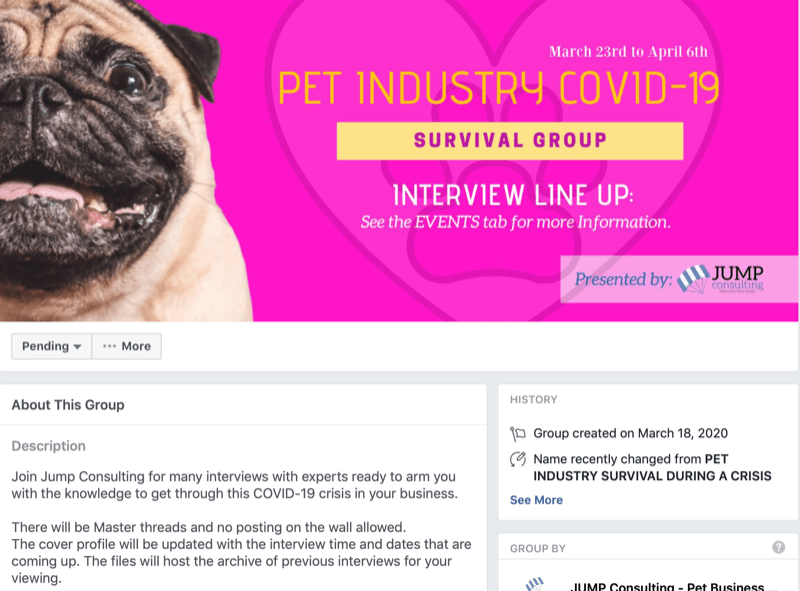
Get World-Class Marketing Training — All Year Long!
Are you facing doubt, uncertainty, or overwhelm? The Social Media Marketing Society can help.
Each month, you’ll receive training from trusted marketing experts, covering everything from AI to organic social marketing. When you join, you’ll also get immediate access to:
- A library of 100+ marketing trainings
- A community of like-minded marketers
- Monthly online community meetups
- Relevant news and trends updates
#2: Promote Your Pop-Up Facebook Group to Build a Community
To get people to join your pop-up group, there are a number of places you can promote it.
Add a link in your website navigation bar. Because prospects are probably on your website looking for information about you, add a short link to your latest pop-up group in your navigation bar. Real estate is prime so keep the wording straightforward.
Share a link in your welcome email. Whenever a prospect signs up for your email list, take a moment to send them a welcome email that includes a freebie along with your background. Right above the footer is a good place to add some info about your pop-up group. After the prospect opts for a freebie, include your link to keep the conversation going.
Include a call to action (CTA) on your Facebook cover photo. This is the horizontal header image that greets your Facebook page visitors. In the caption of that image, provide details on how to join your pop-up group. It's one of the craftiest strategies out there.
And as always, organically share the pop-up Facebook group to your other audiences like podcast subscribers, blog subscribers, video followers, and social media followers.
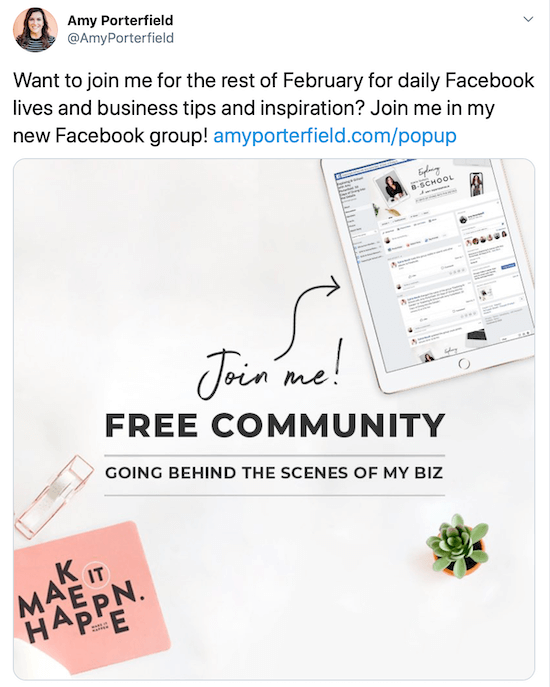
Be creative but also strategic. Don't allow just anyone to join your Facebook pop-up without providing some information—their name and email address at a minimum.
Take advantage of the opportunity to ask prospective members questions. We love using this feature to find out what people's biggest struggle is in relation to our offer and whether they're willing to invest in themselves and their business to solve the pain point the offer solves. To visualize this, you might ask something like, “Are you willing to invest in yourself and your business to grow your audience lightning-fast?”
Asking pending members questions helps you in the planning process (to identify people's needs). It's also a way to build your email list and directly communicate with members. A surefire way to add subscribers is to make Facebook group members opt in before gaining access to the group. Through email, you can get people excited about the pop-up, communicate important details, and keep the conversation going after the event.
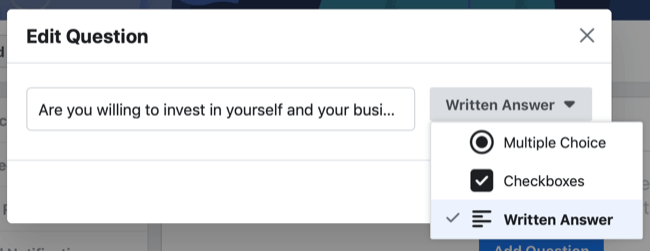
Pro Tip: It often takes a village for pop-up Facebook groups to succeed. You may need to work with others to create value for your group once it goes live. Depending on your format, consider reaching out to others in your industry, experts, and past customers.

Discover Proven Marketing Strategies and Tips
Want to go even deeper with your marketing? Check out the Social Media Marketing Podcast! Publishing weekly since 2012, the Social Media Marketing Podcast helps you navigate the constantly changing marketing jungle, with expert interviews from marketing pros.
But don’t let the name fool you. This show is about a lot more than just social media marketing. With over 600 episodes and millions of downloads each year, this show has been a trusted source for marketers for well over a decade.
#3: Engage Your Pop-Up Facebook Group Members
The purpose of your pop-up group is to create an engaged community with a shared mission or interest, help members through the process, and then prime them to take the next step to reach their goal—through your paid offering. All of your group content should focus on keeping people committed to the group while seeding your end offer throughout the process.
You need to do this in a noninvasive, transparent way so you don't come off as “salesy.” And yes, it's perfectly fine to have people who are just interested in the free pop-up but aren't ready to commit.
Start by pinning a post that explains the mission of the group. A video adds a more personal touch and lets people see your personality. Also consider including links to relevant free resources from your brand. Tell people to turn on notifications for the group so they can continue to engage and not miss out on anything.
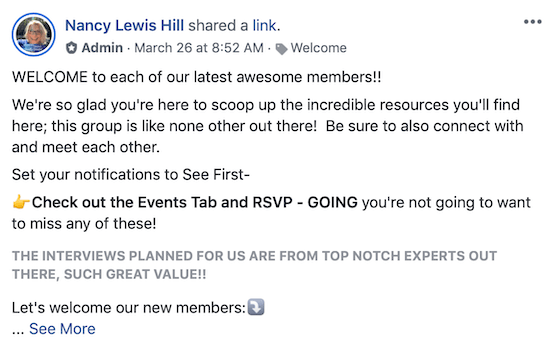
Content to Boost Engagement
One of the biggest concerns for people wanting to start a Facebook group is that they'll create a group and no one will engage in it.
Types of content that work best for a pop-up group run the gamut so you'll need to test, test, test. Try tying in a challenge to engage with members. While you want to stay away from “how” content, your audience might welcome some tips. Keep it light and wait until people enroll in your program before you provide homework.
Here are some other types of content you might share in your group.
Create an introductory thread. Your first pop-up group post should introduce your brand and tell members what to expect. Also invite them to comment on the post and tell you about their business. Ask a personality-based question to get them talking, like, “What are you struggling with right now?” This approach will help boost the engagement for that post and get better visibility in the news feed.
Plan themed posts. Themed posts not only help with your content strategy but also spark conversation and coax lurkers to participate. These posts provide your group with a loose structure that guides conversations and tempts people to take action. If your pop-up group lasts 15 days, for example, it's much easier to think of 15 unique themes to guide your content, all while leading to your sales goal.
Go live in your group. Broadcasting a Facebook Live video in your group helps you connect with all of your members in real time, build rapport, and get instant feedback on whatever you're live-streaming about. Ask me anything (AMA) or free trainings work well for live broadcasts.
Create polls. In addition to engaging your pop-up group, polls can help you gather some serious intel from your members. Facebook's GIF-supported poll capabilities add to the fun of asking questions. On the engagement front, polls require merely the click of a button. Here are a few ideas for using polls in your pop-up group:
- Solicit ideas for your next blog.
- Survey members to see what offers they might be interested in.
- Ask what stage of the business lifecycle they're in. This could give you an idea of whether they'll buy at the end of your pop-up group.
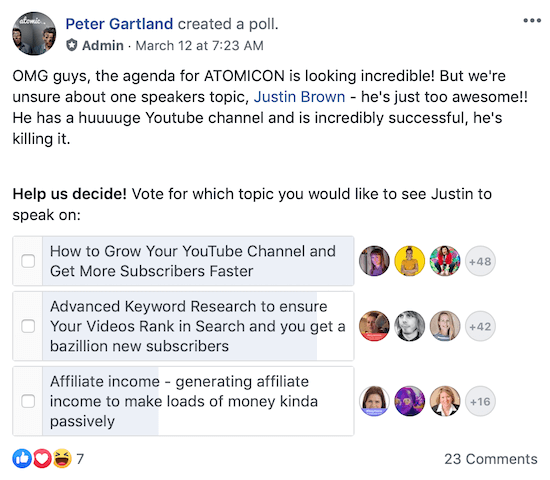
When you're planning content for your group, lean on the medium where you're most proficient. You could share Facebook Live videos in a Q&A or interview format, pre-recorded mastermind video series, exclusive podcasts, or even just content posts.
Another tactic to encourage engagement is to offer incentives. If someone shows up to all of your Facebook Live broadcasts or invites five friends to the pop-up group, they could be entered into a drawing for $1,000, for instance.
Regardless of the agenda for your group, make sure you manage the process. Think of yourself as the host of a party and guide guests along the way.
#4: Convert Your Pop-Up Facebook Group Members Into Customers
Your “afterparty” should run for at least 3–5 days so you have time to move people into your sales process, answer questions, do behind-the-scenes walkthroughs of your offer, and broadcast Facebook Live videos to engage members who are interested in joining. You can even do live videos with your case study people if they're open to it.
Day 5 is when you present your “ask.” Make your pitch or promote the freebie that leads into your sales process. This could be asking people to:
- Join a webinar where you present more information about your paid offering.
- Opt into another freebie such as a video series or challenge.
- Register for your product or service directly.
It's important to have a strong plan in place with your team that results in closing the sale for those who are interested.
A few of my favorite “asks” are moving from day 5 into a free workshop, live-stream training, free video series, or even a free one-on-one call to determine if the member is a good fit for your offer. The main priority on day 5 is moving people from a free experience into the sales process.
#5: Close Your Pop-Up Facebook Group
Once you commit to the final day and what the next steps entail, turn off the group at the close of that day. Be sure to archive the group, which allows people to still see the content but no longer engage. Making sure the group is still accessible creates a bit of FOMO (fear of missing out), lets people know this part of the event is over, and directs those who are ready to take the next step to the appropriate channels.
When the Facebook pop-up is complete, always end on a positive note by letting people know that you'll notify them if you intend to do another free pop-up.
Conclusion
Pop-up Facebook groups are a super-easy, quick way to build an engaged community who's excited about you, your offerings, and your vision.
What do you think? Will you try a pop-up Facebook group for your business? How might you use one? Share your thoughts in the comments below.
More articles on Facebook groups:
- Discover how to manage a Facebook group your members will value and engage with.
- Find tips for using Facebook Groups features including badges, units, subscriptions, and more.
- Learn the unconventional way to grow a Facebook group with Facebook ads.
Attention Agency Owners, Brand Marketers, and Consultants

Introducing the Marketing Agency Show–our newest podcast designed to explore the struggles of agency marketers.
Join show host and agency owner, Brooke Sellas, as she interviews agency marketers and digs deep into their biggest challenges. Explore topics like navigating rough economic times, leveraging AI, service diversification, client acquisition, and much more.
Just pull up your favorite podcast app, search for Marketing Agency Show and start listening. Or click the button below for more information.

